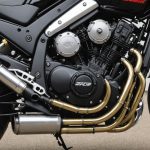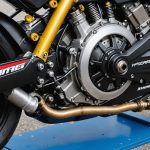Understanding Sport Bike Suspension
To comprehend sport bike suspension, one must delve into various components and their crucial functions within motorcycle mechanics. The suspension system, a fundamental aspect of any motorcycle, ensures both comfort and performance. Below, we’ll explore key elements and their roles in amplifying rider experience.
In essence, a sport bike suspension consists of several parts, primarily the forks in the front and the shock absorbers in the rear. These components work together to absorb shocks and maintain stability. The forks manage the front wheel’s response to road irregularities, while the shock absorbers in the rear stabilize the back of the motorcycle, crucial for controlling the bike during maneuvers.
Also read : Conquering uk emissions regulations: the complete handbook for sport bike compliance
Importantly, these suspension systems offer significant contributions to rider and passenger comfort. They ensure that road vibrations are minimized, reducing fatigue over long rides and providing a more enjoyable journey. Without efficient suspension, every bump and pothole would be jarringly felt, making it uncomfortable and possibly dangerous.
For sport bikes, suspension options vary, offering different levels of adjustability. Some advanced systems allow riders to tailor the suspension settings according to their preference and riding conditions, thus optimizing comfort and performance. Understanding these options is vital for riders who wish to enhance their biking experience.
Also read : Mastering rearset installation and adjustment for superior sport bike comfort on british roads
Impact of British Roads on Motorcycle Suspension
The British road conditions are notoriously challenging for motorcyclists, often featuring numerous bumps and irregularities that can significantly affect motorcycle handling. These road bumps are commonly encountered across various road types, from city streets to rural lanes. They can cause substantial wear and tear on a motorcycle’s suspension system over time. When a motorcycle encounters such irregularities, the suspension system is constantly working to absorb the shocks and maintain stability, leading to eventual degradation.
Suspension adjustments are crucial in ensuring a smooth ride and optimal handling. Motorcyclists should regularly inspect their suspension settings to adapt to the varying road conditions. Adjustments may involve tuning the damping or checking the spring preload to match the frequent encounters with road bumps.
Regular suspension checks are essential, particularly when navigating British roads. Consider this: Neglecting these checks can lead to compromised handling, unsafe riding conditions, and possibly expensive repairs. Motorcyclists should prioritise routine maintenance to counteract the adverse effects of road conditions on their suspension systems. By being proactive, riders can enhance both safety and comfort, ensuring that their motorcycles remain well-prepared to tackle the demands of British road conditions.
Essential Tips for Optimizing Suspension
Optimizing suspension is vital to enhance your ride comfort and overall riding experience. Whether you’re a speed enthusiast or a leisurely cruiser, understanding how to adjust suspension settings is crucial.
Techniques for Adjusting Suspension
-
Preload Adjustment: Preload determines how much the springs are compressed at rest. By adjusting preload, riders can tailor the suspension to accommodate different weights and riding conditions. For heavier loads or passengers, increasing the preload can prevent bottoming out.
-
Compression Settings: Compression damping controls how quickly the suspension compresses under a load. For a smoother ride over bumpy terrain, reducing compression can help absorb shocks more efficiently.
-
Rebound Adjustments: This setting affects how quickly the suspension returns to its original position after compression. Proper rebound settings ensure stability and improved handling during spirited rides.
Ideal Setup for Different Riding Styles
Each riding style demands a specific suspension setup. For sporty riding, firmer settings enhance response and control, while a softer setup favors ride comfort for touring.
Balancing the load is particularly crucial when carrying a passenger. Uneven distribution can affect handling and stability. Adjusting settings like preload ensures both rider and passenger experience optimal ride comfort and safety.
Comparisons of Different Suspension Systems
Exploring the intricacies within suspension systems comparison between stock and aftermarket options is key to understanding their unique benefits. A stock suspension is typically designed to offer a balance between comfort and performance for everyday driving. It suits a wide range of vehicles and riders, making it a practical choice for those who need reliability without the need for adjustments.
Stock Suspensions Overview
Stock suspensions often provide a smooth ride on standard roads while maintaining a reasonable level of handling. However, they can fall short in high-performance scenarios where precision and customization options are desirable. Many find stock systems more than adequate, especially for everyday commuting or leisurely drives, where comfort is more of a priority than hitting top speeds.
Aftermarket Suspension Options
On the contrary, aftermarket suspensions offer a world of customization, tailored for specific needs and driving styles. These systems are crafted by numerous brands specializing in performance upgrades, providing enhanced handling and adaptability. Brands like Bilstein, KW Suspensions, and Eibach are renowned for their innovative designs. Aftermarket solutions cater to those looking for superior performance, improved aesthetics, or specialized utility in various terrains.
Considering suspension systems provides insights into how different setups can enhance your driving experience, allowing you to make informed decisions based on your riding style and comfort preferences.
User Testimonials and Experiences
Community feedback plays a pivotal role in enhancing rider experiences, especially when considering suspension adjustments for improved comfort. Here, we will explore insights from various user testimonials that highlight the tangible differences suspension optimization can make.
For many riders, fine-tuning their bike’s suspension settings has significantly enhanced their journeys. One such user testimonial describes transitioning from frequent bumpy rides to smooth travels after adjusting the suspension. This individual’s experience pinpoints the importance of customization for personal comfort, making every ride more enjoyable.
Riders often share case studies showcasing the positive ramifications of suspension optimization in various terrains. Such stories emphasize that thoughtful adjustments can convert discomfort into satisfaction, benefiting both casual and long-distance cyclists. For example, community feedback indicates that sharing tips about suspension settings facilitates collective learning, leading to a richer riding experience for everyone involved.
Another testimonial praises the communal aspect of feedback, suggesting that user-based insights are invaluable for achieving optimal comfort improvements. Gravitation towards this collaborative approach ensures riders constantly learn and adapt, maximizing the potential of their bikes through shared knowledge and collective experiences.
Ultimately, these anecdotes from fellow riders underscore the profound impact of community-driven insights and suspension customization, paving the way for superior riding comfort.
Maintenance Tips for Sport Bike Suspension
Regular suspension maintenance is crucial for ensuring the optimal performance of your sport bike. It’s essential to adhere to a recommended maintenance schedule for suspension components, as this helps to maintain the bike’s stability and handling. Typically, routine checks should be carried out every 6,000 to 8,000 miles or every six months, depending on how often you ride and under what conditions.
Recognizing the common signs of suspension issues is vital for any rider. If you notice unusual noises, leaks, or a decrease in comfort while riding, it might be time to seek professional help. These symptoms could indicate worn-out suspension components that may require expert attention.
For those who prefer a DIY approach, inspecting and maintaining your bike’s suspension system at home can be relatively straightforward. Begin with regular checks of the fork oil level and condition, and ensure no dirt or debris is affecting the shocks’ performance. Keeping the bike clean and lubricated can prevent many suspension problems from occurring. By paying attention to these upkeep tips, you’ll not only keep your bike in top shape but also enhance your riding experience significantly.











